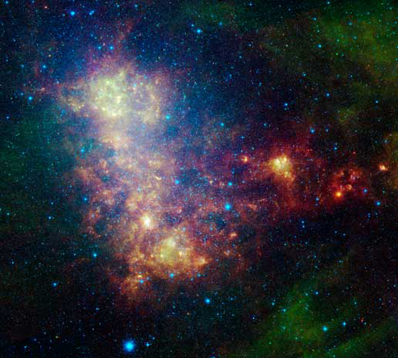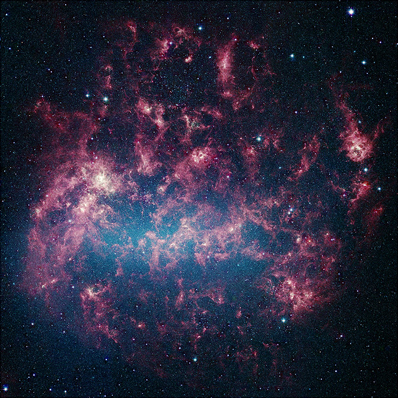


|

|
 |
|
Small Magellanic Cloud gives up its jewels KEITH COOPER ASTRONOMY NOW Posted: 06 January 2010 The Spitzer Space Telescope has produced this wonderfully colourful picture of the Small Magellanic Cloud (SMC) to explore how one of our nearest galactic neighbours is forming stars.  Spitzer’s new infrared image of the Small Magellanic Cloud. Image: NASA/JPL–Caltech/STScI. Spitzer’s new infrared image of the Small Magellanic Cloud. Image: NASA/JPL–Caltech/STScI.
Taken in infrared wavelengths, the colours on display here are not true colours, but merely representations of the infrared light. The blue regions, representing a wavelength of 3.6 microns (3.6 millionths of a metre), show older stars in the SMC; green regions at eight microns indicate dust made from organic molecules that have been recycled through previous generations of stars; and red areas at 24 microns point to places where stars are currently being born in cold molecular gas clouds. “It’s quite the treasure trove,” says Karl Gordon, who led the imaging team from the Space Telescope Science Institute in Baltimore, USA. “Because this galaxy is so close and relatively large, we can study all the various stages and facets of how stars form in one environment.” The SMC is 210,000 light years away and, along with its cousin the Large Magellanic Cloud (LMC), makes a splendid sight in Southern Hemisphere skies. Astronomers have recently discovered that the Magellanic Clouds don’t orbit the Milky Way, but are merely passing through our neighbourhood with an entourage of smaller dwarf galaxies in tow. According to new findings presented this week at the meeting of the American Astronomical Society in Washington, DC, 2.5 billion years ago close encounters with each other and the Milky Way triggered violent bursts of stellar creation in the Magellanic Clouds. The radiation winds from the resulting hot young stars and exploding supernovae blew out rivers of gas that has since become the Magellanic Stream  Spitzer’s 2006 image of the Large Magellanic Cloud. Image: NASA/JPL–Caltech/M Meixner (STScI)/SAGE Legacy Team. Spitzer’s 2006 image of the Large Magellanic Cloud. Image: NASA/JPL–Caltech/M Meixner (STScI)/SAGE Legacy Team.
These cycles of star formation create large quantities of dust that Spitzer, with its infrared eyes, can peer through. It is finding that the SMC is similar to galaxies in the early Universe, in that it is deficient in heavy elements that are produced inside stars. Surveys suggest that the SMC contains merely one-fifth of the abundance of elements heavier than helium that the Milky Way possesses. These heavy elements are crucial for creating planets. The aim of the new Spitzer images is to get a better grasp of how many stars are forming in the SMC right now. “Observations in the infrared give us a view into the birthplace of stars, unveiling the dust enshrouded locations where stars have just formed,” says Gordon. The image was taken early in 2009, before Spitzer ran out of the coolant that keeps its instruments chilled so no thermal noise interferes with the observations. Since May 2009, when the coolant ran dry, Spitzer has been on a warm mission, meaning that it can only observe in specific infrared wavelengths. In 2006 Spitzer also imaged the LMC, revealing even more dusty stars and dust cocooned star-forming nebulae. That image is colour-coded the same as the SMC image, with the blue regions representing older stars that make up the LMC’s small, central bar. |
|
|
|
|